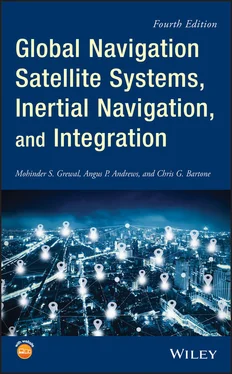In this context, the word art is used in the sense of a skill , craft , method , or practice . The Greek word for it is τεχνυ , with which the Greek suffix ‐ λoγια (the study thereof) gives us the word technology .
1.1.1 Navigation‐Related Technologies
In current engineering usage, the art of getting from A to B is commonly divided into three interrelated technologies:
Navigation refers to the art of determining the current location of an object – usually a vehicle of some sort, which could be in space, in the air, on land, on or under the surface of a body of water, or underground. It could also be a comet, a projectile, a drill bit, or anything else we would like to locate and track. In modern usage, A and B may refer to the object's current and intended dynamic state, which can also include its velocity, attitude, or attitude rate relative to other objects. The practical implementation of navigation generally requires observations, measurements, or sensors to measure relevant variables, and methods of estimating the state of the object from the measured values.
Guidance refers to the art of determining a suitable trajectory for getting the object to a desired state, which may include position, velocity, attitude, or attitude rate. What would be considered a “suitable” trajectory may involve such factors as cost, consumables and/or time required, risks involved, or constraints imposed by existing transportation corridors and geopolitical boundaries.
Control refers to the art of determining what actions (e.g. applied forces or torques) may be required for getting the object to follow the desired trajectory.
These distinctions can become blurred – especially in applications when they share hardware and software. This has happened in missile guidance [1], where the focus is on getting to B, which may be implemented without requiring the intermediate locations. The distinctions are clearer in what is called “Global Positioning System (GPS) navigation” for highway vehicles:
Navigation is implemented by the GPS receiver, which gives the user an estimate of the current location (A) of the vehicle.
Guidance is implemented as route planning, which finds a route (trajectory) from A to the intended destination B, using the connecting road system and applying user‐specified measures of route suitability (e.g. travel distance or total time).
Control is implemented as a sequence of requested driver actions to follow the planned route.
From time immemorial, we have had to solve the problem of getting from A to B, and many solution methods have evolved. Solutions are commonly grouped into five basic navigation modes, listed here in their approximate chronological order of discovery:
Pilotage essentially relies on recognizing your surroundings to know where you are (A) and how you are oriented relative to where you want to be (B). It is older than human kind.
Celestial navigation uses relevant angles between local vertical and celestial objects (e.g. the Sun, planets, moons, stars) with known directions to estimate orientation, and possibly location on the surface of the Earth. Some birds have been using celestial navigation in some form for millions of years. Because the Earth and these celestial objects are moving with respect to one another, accurate celestial navigation requires some method for estimating time. By the early eighteenth century, it was recognized that estimating longitude with comparable accuracy to that of latitude (around half a degree at that time) would require clocks accurate to a few minutes over long sea voyages. The requisite clock technology was not developed until the middle of the eighteenth century, by John Harrison (1693–1776). The development of atomic clocks in the twentieth century would also play a major role in the development of satellite‐based navigation.
Dead reckoning relies on knowing where you started from, plus some form of heading information and some estimate of speed and elapsed time to determine the distance traveled. Heading may be determined from celestial observations or by using a magnetic compass. Dead reckoning is generally implemented by plotting lines connecting successive locations on a chart, a practice at least as old as the works of Claudius Ptolemy (∼85–168 CE).
Radio navigation relies on radio‐frequency sources with known locations, suitable receiver technologies, signal structure at the transmitter, and signal availability at the receiver. Radio navigation technology using land‐fixed transmitters has been evolving for about a century. Radio navigation technologies using satellites began soon after the first artificial satellite was launched.
Inertial navigation is much like an automated form of dead reckoning. It relies on knowing your initial position, velocity, and attitude, and thereafter measuring and integrating your accelerations and attitude rates to maintain an estimate of velocity, position, and attitude. Because it is self‐contained and does not rely on external sources, it has the potential for secure and stealthy navigation in military applications. However, the sensor accuracy requirements for these applications can be extremely demanding [2]. Adequate sensor technologies were not developed until the middle of the twentieth century, and early systems tended to be rather expensive.
These modes of navigation can be used in combination, as well. The subject of this book is a combination of the last two modes of navigation: global navigation satellite system (GNSS) as a form of radio navigation combined with inertial navigation. The key integration technology is Kalman filtering, which also played a major role in the development of both navigation modes.
The pace of technological innovation in navigation has been accelerating for decades. Over the last few decades, navigation accuracies improved dramatically and user costs have fallen by orders of magnitude. As a consequence, the number of marketable applications has been growing phenomenally. From the standpoint of navigation technology, we are living in interesting times.
Satellite navigation development began in 1957 with the work of William W. Guier (1926–2011) and George C. Weiffenbach (1921–2003) at the Applied Physics Laboratory of Johns Hopkins University [3], resulting in the US Navy Transit GNSS [4]. Transit became operational in the mid‐1960s, achieving navigational accuracies in the order of 200 m and remained operational until it was superseded by the US Air Force GPS 28 years later. The Transit navigation solution is based on the Doppler history of the received satellite signal as the satellite passed overhead from horizon to horizon – a period of about a quarter of an hour. The US Navy also developed the TIMATION (TIMe/navigATION) in the mid‐1960s to explore the performance of highly accurate space‐based clocks for precise satellite‐based positioning. While Transit and TIMATION were “carrier‐phase” only‐based systems, the US Air Force 621B experimental program validates the use of ranging codes for a global satellite‐based precision navigation system. These programs were instrumental in the concepts and techniques in the development of GPS as well as other satellite‐based GNSS that we know today.
Currently there are several GNSS in various stages of operation and development. This section provides a brief overview of these systems, where a more detailed discussion is given in Chapter 4.
The GPS is part of a satellite‐based navigation system developed by the US Department of Defense under its NAVSTAR satellite program [5–16].
Читать дальше












